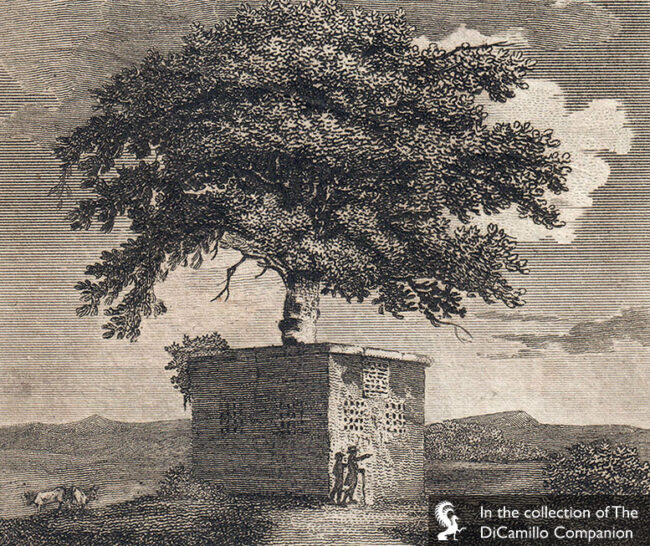
Boscobel House from an engraving in the February 1809 edition of "The Gentleman's Magazine"

The famous Royal Oak from an engraving in the February 1809 edition of "The Gentleman's Magazine"
Earlier Houses: The site of the house was originally occupied by the 12th century Priory of St. Leonard at Brewood, commonly called White Ladies Priory, an English priory of Augustinian canonesses whose name derived from the white religious habits worn by the canonesses. The priory, whose ruins are today listed as Scheduled Ancient Monuments, was dissolved in 1536 as part of the Dissolution of the Monasteries.
Garden & Outbuildings: Circa 1630 John Giffard extended a 16th century farmhouse north of White Ladies Priory to create a hunting lodge he called Boscobel House. The Giffards were recusants (Catholics who refused to attend Anglican services) and, during the Civil War, fervent Royalists (supporters of the king). After his defeat on September 3, 1651 at the Battle of Worcester, King Charles II rode through the night to the Giffards' estate, where he knew he would find safe haven. Charles Giffard escorted Charles to White Ladies early in the morning of September 4, where the king was able to rest. After failing to cross the River Severn the next day, the king returned to White Ladies on September 6. The priory was not considered safe, so the king, disguised as a woodsman (his face covered in soot), was moved to Boscobel House, where he was admitted by George Penderell, a servant of the Giffard family, who took care of the king. Charles was met at Boscobel by William Careless (a loyal supporter with whom the king had escaped the battlefield at Worcester), who said Boscobel House was unsafe and recommended that Charles hide in an oak tree in the woods surrounding the house. The king and Careless brought food and drink with them and spent all day hiding in a pollarded oak tree that later became known as the Royal Oak (see "Images" section). After the patrols of Parliamentary soldiers searching for the king left the area, Charles climbed down and spent the night of September 6 hiding in one of Boscobel's priest holes, after which he was moved to Moseley Old Hall, another Catholic safe house, and, ultimately, to the continent. After the Restoration Charles granted an annuity to the Penderell family (still paid to their descendants today) and created Careless a gentleman of the Privy Chamber. The Penderells and William Careless both employed coats of arms that depicted an oak tree and three royal crowns. A fine embroidered tapestry entitled "The Restoration of King Charles II," today at the Holburne Museum of Art, Bath, shows Charles hiding in the oak tree at Boscobel House. In 1918 the 5th Earl of Bradford purchased White Ladies; though his descendants continue to own the larger estate, the Grade II*-listed Boscobel House (which was added to in the 19th century), and the adjacent ruins, were placed in guardianship for the nation in 1954; in 1984 the 7th Earl donated the freehold of Boscobel House to English Heritage, who continue to own it today.
House Listed: Scheduled Ancient Monument
Park Listed: Not Listed
Past Seat / Home of: William Skeffington, 16th century. Edward Giffard, 16th century; Charles Giffard, 17th century; Giffard family here from circa 1551 until circa 1650. Basil Fitzherbert, 17th century; Fitzherbert family here until 1812. Walter Evans, early 19th century. Orlando Bridgeman, 5th Earl of Bradford, 1918-54.
Current Ownership Type: English Heritage
Primary Current Ownership Use: Visitor Attraction
Ownership Details: The ruins and grounds of the priory are open the public, together with nearby Boscobel House, which is also owned by English Heritage.
House Open to Public: Yes
Email: [email protected]
Website: https://www.english-heritage.org.uk
Historic Houses Member: No